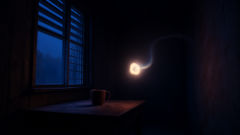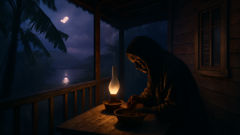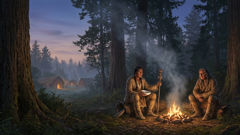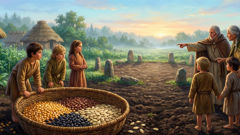Introduction
The soucouyant arrives on a night when the moon is a thin coin and the sea breathes quietly against the reef. Long before the street lamps, before the diesel hum of generators, the island’s nights were measured by the creak of shutters and the slow cadence of crickets. In those hours old women sat on their porches with bowls of pepper and washed over with lamplight; men smoked, and children were kept close. It was in such a hush that the stories were strongest—told in low voices like prayers: keep your doors tied, scatter salt, do not leave a glass of water unattended. The soucouyant, the villagers said, was more than a ghost. She was a woman who had learned to slip away from her own flesh. By day she limped and mended nets, or she sat hawking bitter cassava bread; by night she peeled off her skin and became a small, burning lantern with a hunger for blood. The telling shaped how the island moved. Paths were walked with palms pressed to the ribs; doors had beads threaded across them; babysitters watched the backs of sleeping children until dawn. The creature was not simply feared for physical danger; she was feared because she exposed breaches in the social fabric—the secrets, jealousies, and bargains people made. This story unfolds in the small town of San Roque, a place halfway between the sugarcane fields and the coral shelf, where one long dry season altered the habits of its people and one soucouyant altered the lives of a few who would not let fear dictate their choices. Here, amid banana leaves and the smell of oiled wood, a young schoolteacher returns to care for an ailing aunt and unravels a truth that is older than the bridges and newer than the radio antennae. She will learn the rituals that keep fire-lights from slipping through shutters, the signs that a neighbor is not what she seems, and the strange mercy that sometimes grows from confronting a horror with kindness. This is a tale at once of the supernatural and the human—of how communities survive the dark by remembering what to do when the night takes a familiar shape and becomes something other.
Roots of Fire and Flesh
When Elena stepped off the morning bus into San Roque, the town seemed smaller than the postcards she remembered. The bakery still burned its last loaves at dawn, but the signboard was a little more weathered; the church bell leaned and rang with a tremor she had not noticed as a girl. She had come back because her aunt, Lela, had taken to coughing in a way that shook her bones. There were practical reasons—pulled sheets from the market, a patch of yard that needed weeding—but there was also the old pull of belonging to a place whose rhythms were tied to the sea. Elena had been taught as a child to respect the stories without being swallowed by them. Her mother had told her: “The stories keep you safe; they are like fences.” And yet, fences can also keep the unknown out of sight while it moves within.

The first winter without rain in the county tightened mouths and tempers. People grew anxious, and when people grow anxious they look for names to pin their fears to. In San Roque those names were as old as the roof beams: the mother who was angry at her son for leaving, the widower who drank to forget, the teacher who took headfuls of rum before supper. Sometimes the soucouyant was an explanation, sometimes a retribution. Aunt Lela, Elena learned, was both feared and tended. She was the last of a line of midwives who had delivered half the town; she knew how to tie umbilical cords and press warmth into small chest cavities. Yet she wore thick skirts and thin smiles, and after the sun went down she would sit by the window with a lantern that did not always match its glass—the flame seemed to have a life of its own. People crossed the street when they met her; children were told not to stare.
The legend of the soucouyant in Elena’s notebook was precise and cruel. A woman who discarded her skin—perfect, intact, folded away like a garment—remained in the house at night, pretending to sleep. The body that remained had no teeth and no appetite, and yet it had the appearance of old age so people would not suspect it. The woman who became the ball of fire would slip through a crack under the eaves and fly, small as a moth, through keyholes and cracks to drink the blood of sleeping men and women. In the morning, the marks—the pinpricks on a neck, the pale spots where lotions had been applied in haste—would be explained away as mosquito bites or the graces of a bad dream. Only the ritual could stop her: salt at the threshold, an egg overturned at the door, a handful of chilli ash thrown at the turning of the light. If a person found the discarded skin, they could lay coarse salt on it or, according to some elders, stitch it with a needle of iron—the right kind of needle—to prevent the woman from returning to it, forever trapping her.
Elena watched how people moved with those precautions. She watched old men shaking salt from paper at the parish dance, women tapping eggs under baking boards as if they were charms. Once, at dusk, she saw a child leave a glass of water on an outside step—the ritual said never to leave water for a soucouyant, for she will dip in and discover where it came from. The child’s mother snatched it away and sloshed salt into the rim. “You see?” her mother hissed. “How careless.” The lesson was practical and moral: in a small town, habits are laws.
Aunt Lela’s cough grew loud as cane knives, and Elena learned to cook the sage tea that steamed in the kitchen like a small blessing. She learned the song Lela hummed when pinning clothes; a low mnemonic she later discovered was not a song at all but a set of names repeated like rosary beads—women’s names, and under them a few words in an older tongue. Elena asked once about the names, and Lela said only, “These are the ones who came before. You call the dead into your mouth sometimes to remember how to sew.” It was an aunt’s shorthand for lineage, but Elena could not help sensing the words as wards.
Not everyone agreed on the soucouyant’s origin. Some traced her to greed—women who had stolen from others and paid the price. Others said the soucouyant was a woman turned cruel and jealous by a lover’s betrayal, her heart hardened into ember. The storytellers—the fishermen with their tobacco, the younger men who had learned to mimic Aunt Lela’s cadence—gave her different faces to fit whatever the town needed to be afraid of. Elena, who had been trained to look for evidence, wondered if the tale had a more ancient bed: a lineage of outsiders, women who practiced herbcraft, who knew the elements and were therefore suspect to those who relied on trade and church and law to keep order. The soucouyant, in that telling, was a scapegoat: a projection of the anxieties of a community that had been changing fast. Yet when the lantern flame appeared in the narrow slit of a window and slipped like a something alive, fear ignored argument.
The first night Elena saw the light she thought it was a moth caught on a lantern. She sat at the kitchen table and the lamp burned like a throat. The light came, small and humming, and then it pulsed blue. It slipped along like a small comet, moving against the air as if swimming through oil. Elena’s heart sounded like a drum inside her. She wanted to wake Lela, to press her hand and ask if she’d seen—yet the old woman’s chest rose and fell with a sleep deeper than illness. The small flame circled the room, and Elena felt the heat on her skin though the window was shut. It touched the tip of a teacup and then withdrew, like an animal that had been stung and remembered it. In the morning there were pinpricks on the back of Lela’s neck—three, like the teeth of a small beast—and a smear of grease on the windowsill that was not the lamp’s oil. Someone would say later it had been an insect’s work, that it was only a fever dream. But Elena kept salt in the hem of her shirt and the names of the song under her tongue.
Stories ought to end in warnings or solace. This one answers neither quickly. For when a community chooses a scapegoat—whether called soucouyant or anything else—it must face the moral price of its choice. Elena would learn the names one by one: neighbors who had once been kind, children who had grown into something sharper, and the strange tenderness that sometimes settled around those accused. She would learn how rituals could save, and how they could cut off those who were already alone. The soucouyant was not merely the creature of the myth; she was also a mirror. In the next nights, as the island’s nights lengthened and the sugarcane stood sharp against the moon, the flame returned. And the town, with its frayed borders and weathered windows, had to decide what to do with the woman who slipped between the skin and the dark.
Salt, Needles, and the Mercy of Dawn
The second month was the cruelest. Word of the soucouyant spread outward from San Roque like oil on water and found purchase in markets and lunch tables. Traders from the other side of the bay began locking the shutters before sunset. Schoolchildren whose parents were ashore were kept overnight in the parish hall under a heavy watch of aunties with rosaries and pepper pots. Elena, who had arrived merely to nurse and keep a house, found herself sliding into the rituals as easily as into an old slipper: she tied a length of red thread across the back door, she dumped salt in a path under the kitchen sill, she learned the pattern for an egg’s motion to break a bad dream. Ritual, once learned, is a language of intention—small acts meant to redirect chance—and Elena spoke it fluently now, not because she believed fully but because actions sometimes hold luck in their hands.

On a particular night when the moon had been swallowed by cloud, the soucouyant tried something new. The flame rose not from any familiar eave, but from the thatch of the neighbors’ house two doors down. The flame was smaller than a coin and moved in jerks as if it were trying to remember itself. It hovered near a child’s cot and paused. That child was a baby named Tomas who had the half-smile of toddlers who sleep too much. When Elena crossed the street she saw the flame retreat into a crack and reappear as if proofing a seam. The neighbor, a woman named Violette, had left her front door open for a breeze. You can imagine the rest: the ritual broken, the water-cup left on the stoop because the mother, pregnant and fatigued, had forgotten the old warning. When the baby screamed in the morning—sharp, wet—there were no marks, no dried blood, but Tomas’s cheeks were paler than the bread. Violette leaned into her spindle and refused to talk of anything but milk and doctor’s visits. The soucouyant had tasted and moved on, or else the town had been spared by a mercy that some elders called the island’s grace.
Fear can be a weapon. The town’s gaze, sharpened by rumor, began to fall on faces and gestures: a woman who kept an extra pot of herbs; a man who never married; an old fisherman who spoke quietly of the sea’s moods. Elena saw how quickly suspicion hardened into certainty. The worst nights were not the ones with the flame but the days when neighbors called one another into curt conversations and left with eyes that checked the sky. Aunt Lela, whose cough had always been a cloak for something else, started to be treated with a different kind of caution. Or perhaps the town always watched the same way and she had simply come to feel it. Some nights she would disappear into the back room and lock the door, humming the low names. Others she would sit with her lamp and pick at the hem of her dress as if removing a scab.
A meeting of the town elders convened beneath the breadfruit. They spoke in the old polite anger of people who know they must be wise but lack the power to be perfectly just. “We must mend the net,” said Old Mateo, tapping the cane that doubled as his authority. “We must keep the children safe.” They recommended salt lines, visits from a visiting priest who could bless basins, and a watch that would patrol between midnight and dawn. Some suggested visiting Aunt Lela’s house to ask if she needed anything; others—the ones who balanced between superstition and brutality—muttered that if someone was found with a discarded skin, it must be bound and burned. Elena felt the air tighten around those words like a noose. The crowd had begun to hunger, sometimes, for a clean sacrifice.
One evening, as rain finally came like a curtain and the town exhaled, a discovery fractured the fragile truce. A small, pale envelope lay on a doorstep—inside, what looked like old, flaking skin folded like a negro cloth. It was not the right color for human flesh: it reminded Elena of the underside of a dried leaf and smelled faintly of cassava and camphor. People came in a clutch, and their voices rose sharp and small. Mateo declared that it must be a soucouyant’s skin and the council gathered to decide what to do. The more fearful wanted to burn; the more careful wanted to call the priest and lay salt. Elena felt the town’s moral compass wobble under heat. She understood the gesture of burning—an attempt to purify—and she also remembered the old songs and names Lela had sung. There were ways to trap a creature and there were ways to punish a woman already broken by accusation.
Elena made a choice that shocked some and saved others. In a thin hour before dawn, she carried the skin into the small church yard and laid it on a bed of coarse salt. She did not light a fire. Instead she set a chair near it and sat with her back to the parish fence. People passed and watched. She hummed those names she had learned from Lela, not as a charm but as an offering. When the rooster cried, an old thing happened: a woman appeared at the far edge of the yard. She moved with careful steps—lame, perhaps, and wrapped in a shawl. Her face was lined like crumpled paper, and her eyes carried a shame that made even those who hated her look away. She did not try to snatch the skin. She did not flee. She laid a hand on the fence and watched Elena as if asking silently for a story to be told differently.
“What are you doing?” Mateo spat from the shadow. Elena said nothing, only kept humming. The woman—who later would be called Mara by some and Lenora by others—came forward. Her posture was like someone used to being small. She stood across from the skin and placed her palm beside it. They looked at one another as people look when they recognize the history of an unmoored friendship. No flame rose, no sharp sound was heard. The woman whispered something that Elena could not quite hear. It might have been a plea, a prayer, or a memory offered as payment. What mattered was that she did not resist the salt and she did not take the skin. Elena felt the town holding its breath. In a way, the town was inside a larger choice: to be a tribunal or to be a house that tended those who had fallen.
After that night the practices changed. Salt was still placed, needles still waited in the windowsills, and watchers still paced the road, but people became quieter in how they spoke about the old women who courted herbs and night air. A small kindness gave the town a different rhythm. Aunt Lela’s coughing lessened; she smiled more often when Elena brought her hot broth. The woman who had been accused—call her Mara or Lenora—sat under a breadfruit tree and mended nets for those who would accept help. Some nights the flame still came, small and bright, like a remembered wrongdoing trying to find a center. But when it came, the town had learned to do more than punish; they learned to lay salt and to look and sometimes to listen. Rites had always been about control, but they could also be about attention.
There is a lesson that exists in the absence of tidy endings: that monsters are sometimes made and unmade by the ways communities choose to behave. The soucouyant remained a story told around lamps and in marketplaces, a warning and an explanation. But the town of San Roque learned that ritual without compassion becomes a blade; ritual with compassion becomes a bridge. Elena went on to teach in the school and to write the names and songs into a small leather book. She wrote without judgment but with care, because stories that explain also shape what comes next. The soucouyant never entirely left the island—no legend does—but the island stopped giving terror all the room. In its place it carved a narrow space for reconciliation, for small acts that turned fear into a conversation held under the moon and sometimes, astonishingly, into mercy at dawn.
Conclusion
The soucouyant is not simply a creature to frighten children into obedience; she is a mirror for a community’s anxieties and a repository for its darkest suspicions. Stories like hers endure because they carry practical instructions—salt at the threshold, eggs turned under the board—but also because they permit people to speak of betrayal, loneliness, and the price of ostracism. Elena’s return to San Roque did not produce a final triumph over the night, nor did it provide a single explanation that resolved every argument. What it did accomplish was quieter: a reshaping of the rituals, a subtle widening of the space where accused women could be heard without being burned at dawn. In an island culture where oral memory passes from porch to pantry and from aunt to niece, the soucouyant remains lodged in the collective imagination, a flame that teaches the living how to tend one another. The island keeps the story alive not to terrify but to remember—to hold the small acts that guard against harm and to recognize that sometimes mercy, like salt, is a powerful preservative. When the night comes and a bright dot threads itself between eaves, people still glance up and tighten their locks. But there is also a hand that reaches to the other, a bowl of tea offered, and a name called aloud. That soft humanity, more than any needle or broom, is what ensures that a legend does not simply consume a life but transforms a community.













